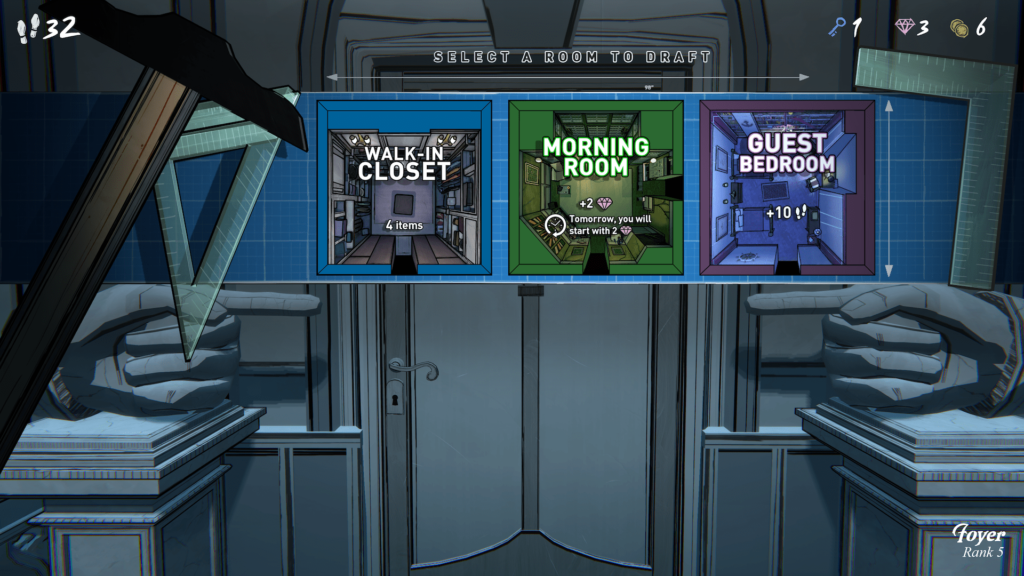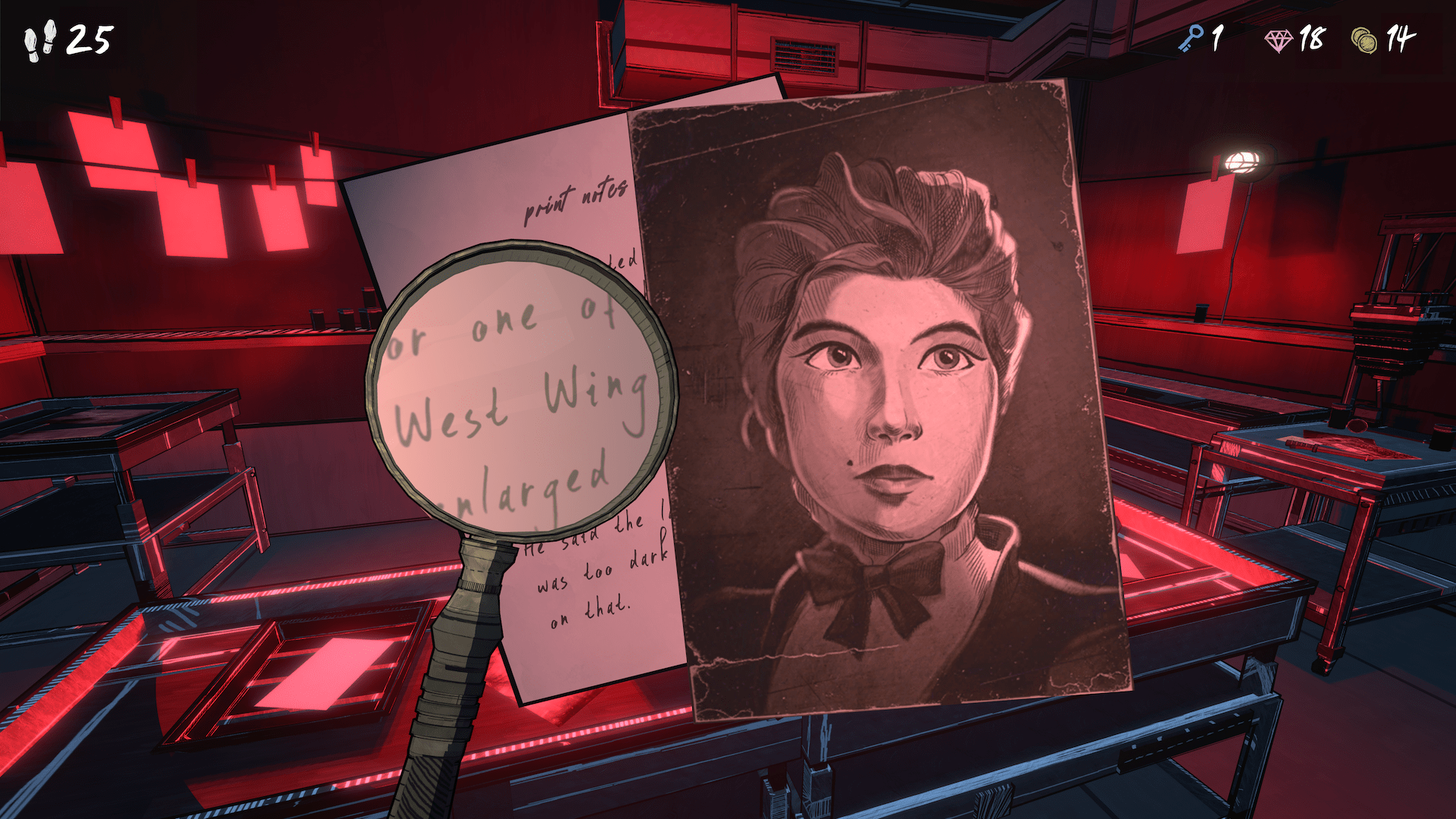I know, I know. It’s become a bit of a faux pas to describe one game using another and yet I am compelled. After a few hours with Blue Prince, I realized this game elicits the same feelings in me as Balatro. Not because it has anything to do with cards or passive-aggressive clowns named Jimbo, but because those hours I played passed as breezily by completely unnoticed as they did when I was knee deep in the poker roguelike. Blue Prince is a time-stealer and as with Balatro, you will be happy to be robbed.
Blue Prince is an architectural puzzle mystery game from developer Dogubomb. In it you play as a young man who inherits his uncle’s magical mansion. On your first day at the house you receive a note laying out the rules by which you will earn your inheritance. This house has 45 rooms. Find the secret 46th room that’s not displayed on any of the mansion’s blueprints (get it, Blue Prince / blueprints) and the house is yours.
To find the 46th room you must create or “draft” rooms one after the other connecting them via their doors. You start each day with 50 steps and passing into a room takes one step (or more depending on the type of room). When you run out of steps you are exhausted and forced to retire for the day. At the end of every day, the layout you drafted is reset and you must start all over again with a blank mansion.
At its heart, Blue Prince is a roguelike puzzle game laid over an overarching narrative involving the secrets of your extended family. Its main mechanic is drafting rooms and laying them out over the mansion’s 5×9 grid. Each room comes with any number of doors that open in one of the four cardinal directions. You build your map each day by trying to connect as many rooms with as many doors while avoiding dead ends as much as possible.
There are so many different types of rooms to draft with their own strengths and weaknesses. Bedrooms, for example, reward you with additional steps extending your day. Closets yield goodies like keys to unlock doors but are dead ends. Drafting a puzzle room early, like the billiard room or the parlor, rewards you with gems to draft higher quality rooms like the library or the laboratory. The more rooms you draft, the more likely you are to encounter rooms you haven’t seen before revealing secrets and clues that will help you in your journey.
On top of trying to draft rooms that will yield you the most benefits, you’re also trying to draft rooms in the correct sequence. Tinkering with the breaker box in the circuit breaker room, will let you open the door in the garage, bringing you that much closer to finding the 46th room. It’s all an interconnected, incredibly dense puzzle game that makes use of every ounce of your brain power to solve and then some. You will need to take notes – the game tells you as much. And any time I need to write stuff down to play a game effectively, it is cooking with the highest quality gas.
Solving puzzles in Blue Prince brings all my powers of spatial, mathematical, narrative, and memory reasoning to bear. And the thing I love about it, something I don’t think I’ve ever said about a video game ever, is its pacing. Blue Prince unfolds almost infinitely — solving one puzzle leads to the next and on and on like a fractal of overlapping mysteries. Some of those mysteries are easy and satisfying to figure out. When I first encountered the darkroom, the lights went out. Not only could I not see what was in there, the darkness forced me to draft the next room without seeing what it was or if it was a dreaded dead end. But I remembered from the circuit room seeing a darkroom setting on the breaker box.
On my next run, I made sure to draft the circuit room and flip on the power before drafting the darkroom. When I went in, voila, the power stayed on and I collected a treasure trove of new clues.
But the game’s other mysteries are less intuitive and can lead to frustration that no amount of note taking can assuage. The dartboard in the billiard room is a mathematical puzzle with different colors on the board corresponding to different functions. At first it was easy enough to figure out: blue next to a number means addition, yellow is subtraction, pink is multiplication, and purple is division. Instead of recalling the elementary lesson of PEMDAS, order of operations is determined by working from the inside of the dartboard out.
After about 20 or so days, when I had everything down pat, the dartboard began throwing new symbols and colors that were far less intuitive. I just could not figure out what to do and it got so frustrating that I avoided drafting the billiard room altogether, locking me out of obtaining valuable keys.
(Author’s note: another extremely frustrating and frankly unacceptable thing about the billiard room is that solving the puzzle requires the ability to see in color and as of this writing there are no colorblind settings. From comments about this on social media, the developers are working on deploying colorblind options, hopefully soon.)
There is a story in Blue Prince but from what I’ve seen so far, it has little bearing on the puzzles and isn’t all that interesting. There’s a mystery involving members of your family’s political leanings, a missing author, and a disgruntled employee, but I’m so hungry to figure out how to open the door to the basement that I don’t pay it much mind. I’m about 27 hours in, which feels pretty hefty for a puzzle game. And I feel with all that I’ve uncovered and all I think I have left to uncover, I could go 30 hours more and it would pass in the blink of an eye.
Blue Prince is out now on Xbox, PlayStation, and PC.
Content shared from www.theverge.com.


